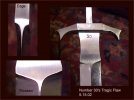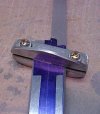- Joined
- Dec 7, 2000
- Messages
- 5,179
This was my first time working with stainless for fittings, and while all the stories about the difficulty working it seem to be true, its permanence far outweighs any trouble that might be. I'm totally converted to stainless, it'll be hard to get me to use anything else from now on.
I'm convinced my trouble with pictures is my camera, it just doesn't have the resolution needed for this. Sorry about the crappy pic.
Specs:
Blade is 440C
12" overall, 6.75" blade
Guard, Ferrule and Pommel are stainless
Handle is stainless wire over oak
This knife has a major flaw in the grinding, and I'll add a pic following this post showing my mess.
Dave
I'm convinced my trouble with pictures is my camera, it just doesn't have the resolution needed for this. Sorry about the crappy pic.
Specs:
Blade is 440C
12" overall, 6.75" blade
Guard, Ferrule and Pommel are stainless
Handle is stainless wire over oak
This knife has a major flaw in the grinding, and I'll add a pic following this post showing my mess.
Dave



